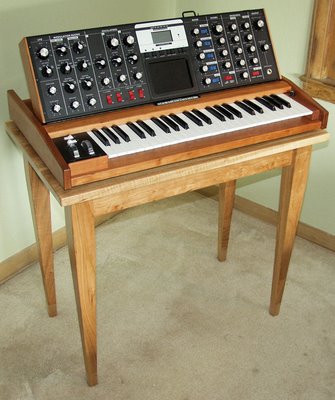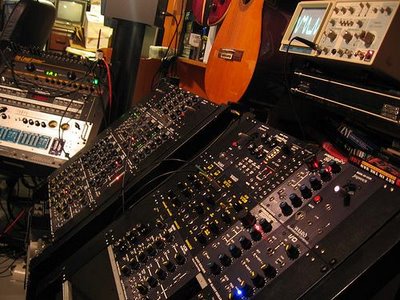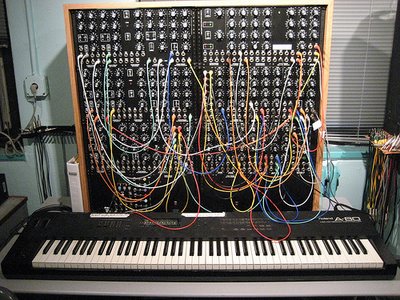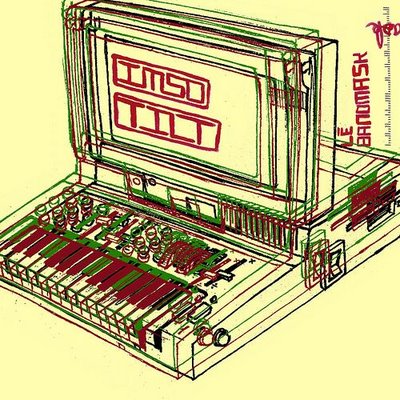 Title link takes you to a video of this modular on SoNiCbRaT.
Title link takes you to a video of this modular on SoNiCbRaT.
Thursday, November 23, 2006
Multivox MX-75 Dual Voice Synthesizer
 flickr by zonkout.
flickr by zonkout."These switches are for different instrument sounds. They are presets of brass, reed & voice, air reed, bow string, pluck string, & strike sound on the 1st 12 switches. The other 3 are synthesizer effects (space sound 1&2, cat/frog sound, & noise/ring modulator)." "The input jacks read as follows: control knob for audio, 1st V.C.O. syncro, V.C.F. frequency, and CV & Gate. The outputs are: Key Gate, 1st & 2nd syncro, and low and high audio"
Title link takes you to more.
synth rack

"Kurzweil K2000, Alesis Ion, Ensoniq SQ-80, DSI Evolver, Yamaha QY-70, AirFX and Electro-Harmonix 2880 looper."
flickr by sarendipatree. Title link takes you to a few more.
Wednesday, November 22, 2006
DIY Site
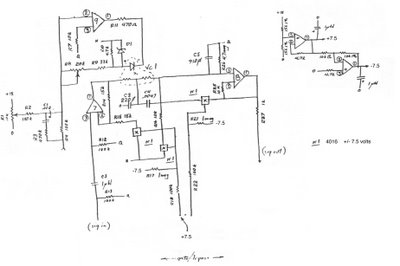 Title link takes you to a DIY site featuring:
Title link takes you to a DIY site featuring:RSF Kobol Expander Waveshaper
RSF Kobol Expander Sawtooth Oscillator
Buchla "Timbre" Waveshaper
Buchla Lopass Gate (pictured)
Buchla 258 style oscillator
ARP Odyssey 2 quadrant modulator
Source of Uncertainty
Buchla Bandpass Filter
Three position toggle switch
Vactrol Crossfader
via sequencer.de
Korg Trident
 Title link takes you to shots pulled via this auction.
Title link takes you to shots pulled via this auction.Details:
"This particular example is in superb condition and in full working order, there’s no wear on the silk screen, no noisy pots and all the keys are in line, also included are the original user and photocopy service manuals.
The Trident is a 61 note, 8 voice, analogue polyphonic synthesizer, it was Korgs answer to the Jupiter 8, OB8, P5 etc, it's basically three synthesizers in one keyboard, it has a synth, brass and string section that can be played independently or all together for an immense sound, each section has it's own volume control and independent outputs. The Trident uses SSM chips as on the Prophet 5 rev 1&2 which are favoured over the curtis chips as there noted for being fatter and warmer sounding.
The keyboard has a split/layer facility, each section can be independently above or below middle C or across the whole keyboard. It also has a built in flanger that can be assigned to each section.
There's been a mod added to the pitch/mod panel to the left of the keyboard, it's an octave range switch that's very useful for reaching the highest notes.
The Trident is built like a tank and easy to use, the controls have a straight forward layout and it doesn't take you long to get good results, all the parameters are there to be tweaked and the keyboard is one of the best I’ve used on a vintage synth. Its also very stable and reliable, it only needs 5-10 mins to warm up, iv'e had it on for days and it's never gone out of tune once.
This is a highly underrated and very special synthesizer that is capable of producing beautiful warm analogue soundscapes that no modern digital synthesizer can get near to, the strings and pads in particular are truly outstanding. I simply can't do it justice by writing about it here.
These are rare, especially in this condition and would make a great investment and addition to anyone's studio.
For those lucky enough to have owned one or to have played one then you'll know exactly what you’re bidding on.
This is a big heavy keyboard (1020x525x160, 22Kg) and I don't have a flight case for her so it's pick up only, I am willing to deliver the synth my self but will charge 25pence per mile, UK mainland only."
Saw this one on Failed Muso.
Lassence u-Ventury
 Title link takes you to more shots sent in by an anonymous reader.
Title link takes you to more shots sent in by an anonymous reader.Update: you can find the manual here.
AudioRealism Drum Machine
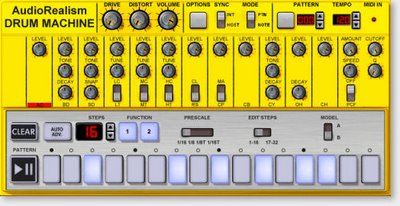 "Deep flavored bassdrums, crispy snares and saucy hihats is the stew that made the analog drum machines so tasty. AudioRealism Drum Machine contains two modeled vintage drum machines for double the gastronomical pleasure. Sprinkled with a Pattern controlled filter and a distortion unit makes for a pleasurable meal that will satisfy the sweetest tooth to a hard baked sludge for those with tougher digestional systems."
"Deep flavored bassdrums, crispy snares and saucy hihats is the stew that made the analog drum machines so tasty. AudioRealism Drum Machine contains two modeled vintage drum machines for double the gastronomical pleasure. Sprinkled with a Pattern controlled filter and a distortion unit makes for a pleasurable meal that will satisfy the sweetest tooth to a hard baked sludge for those with tougher digestional systems."Features
* Two realtime switchable drum machine models, 11 sounds for Model A and 8 for Model B.
* Internal 32 step sequencer with global accent per step, four prescale selections per pattern
* Various pattern transformation functions
* Full MIDI CC with learning function
* MIDI Output
* Rebirth pattern import
* Two MIDI modes (Pattern and Note)
* Integrated distortion unit
* Pattern controlled filter (PCF)
* Sample accurate sync to host
Title link takes you to some samples including comparisons to a Roland TR-808.
Also check out their Bass Line Pro:

reFuse Software's The Lowender
 "The Lowender plug-in is a subharmonic synthesizer reminiscent of classic analog dual-band bass enhancer circuits."
"The Lowender plug-in is a subharmonic synthesizer reminiscent of classic analog dual-band bass enhancer circuits."Features
* Gate, drive, and output filter controls
* Operates in three different freqency ranges to match program material
* Analog modeling - no FFT shenanigans!
Title link takes you to more info and samples.
SYNTENDO
 "Do you have fond memories of the 8-Bit Nintendo's music?
"Do you have fond memories of the 8-Bit Nintendo's music?Do you wish there was a VST that you could use to make music just like that?
Do you miss the glory days of Sunsoft?
Do you like bleeps and bloops more than granular synthesis or spectrum modulation?
Do you believe Shigeru Miyamoto sold his soul to the devil?
Do you enjoy fondling small, rectangular, multi-buttoned objects?
Do you dream in 64 colors, sometimes swapping mappers accidentally?
Do you consider Mr. Gimmick a dear, close personal friend?
Do you think 8 step sequencers are "just right"?
Do you just really, really, really like free synths?
If you answered yes to any of the questions above,
than Syntendo was made for you!"
Title link takes you there.
via Retro Thing which also mentions Neoretro.
Russian RITM-2
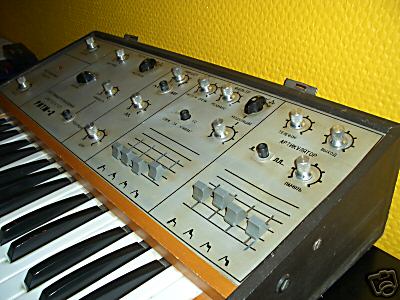
Click here for more shots pulled via this auction.
Details:
" Powerful Soviet Russian Vintage RARE Analog synthesizer.
• RITM-2 is a portable solo synthesizer from 80's - Russian clone of Minimoog, it has 1-osc (plus sub osc), 1LFO, 2 adsr and more.
• This synth was made in December 1988 in USSR
• First section - Portamento/Glissando.
• Modulation section - modulation frequency knob (LFO), OSC section: tuning knob from - to + , modulation switch from saw, tri and random, tone switch from 32', 16', 8' or 4' , modulation level knob from 10 till 2; modulation on/off switch (linked to level knob).
• Mixer section - noise level knob, saw wave level knob, tri wave/rising tri wave switch, level of tri/rising wave.
• Filter section : cutoff freq knob, resonance, modulation switch - choose envelope, tri, wave or random,modulation level knob, keytrack button (between 1/1 keytrack or 1/2); 4 x sliders for adsr envelope.
• Output section: output volume knob, phones volume knob.
• Amp section: switch between single - triggered envelope and repeating envelope, memory knob, 4 x sliders for adsr envelope.
• Connection on the rear panel : on/off switch, power wire connection (220V), fuse (0,25A) - output. On the front : 2,5 octave keyboard (F-C), to the left of keyboard there are pitch bend slider, modulation wheel, below keyboard there is a output 5-din plug."
Roland RS-09 Organ and Strings Synth
 Title link takes you to shots pulled via this auction. Note the missing switch for Ensemble.
Title link takes you to shots pulled via this auction. Note the missing switch for Ensemble.
Bob Moog Foundation Newsletter #3
 "Since the Bob Moog Foundation's launch, we have received several stories about Dad and his work, and original music featuring Moog instruments. I thank everyone who submitted and invite everyone else to read the stories and listen to the music.
"Since the Bob Moog Foundation's launch, we have received several stories about Dad and his work, and original music featuring Moog instruments. I thank everyone who submitted and invite everyone else to read the stories and listen to the music.Please keep the music and stories coming. We love hearing how Dad touched peoples lives and ultimately that is what the Foundation is all about- touching lives through innovation and creativity.
Moog Lives! Rock on!
Sincerely,
Michelle Moog-Koussa
Director, The Bob Moog Foundation
Below are excerpts from three of our favorite stories about Bob and his inventions. The link below will let you see all the stories in there entirety.
"I am a composer today in part because of the inspiration his instruments provided me. He was, in many ways, the father of all contemporary electronic musicians, and his memory and work will live on forever."
Richard Lainhart
"Ha! When we first put out the Minimoog (1970/71) the stores told us "Keyboard players will never buy this, as they are NOT technical people at all. Guitarists and drummers have their hardware and gadgets to use, but keyboard players only use a piano and organ - they are not TECHNICAL!" Boy - things sure did change!"
Brian Kehew
"Today, I can't claim any successes in the music world and can hardly believe what I had on tape was considered good by any measure, but it was the experience of the time that counted. It gave me depth and experience that carries forward to the professional world. Bob Moog became one of the few people who I could actually call a hero. "
Steve Wiedemann
Read more stories at moogfoundation.org
Supporting the Foundation
We are still a young organization, building from the ground up. To support Bob's legacy in a meaningful way, we need your support. Every contribution counts.
Please consider making a contribution to our Foundation. To find out what we're all about have a look at our objectives.
We ask you to spread the word--forward this email to friends, colleagues, and anyone interested in the work and legacy of Dr. Bob Moog.
Support the Foundation..."
Bob Moog Foundation Newsletter #1
Bob Moog Foundation Newsletter #2
Tuesday, November 21, 2006
MacBeth Studio Systems XFactor
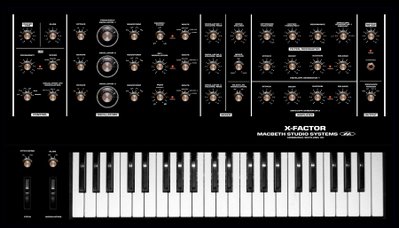 Remember the XFactor? A new rendering just went up on the MacBeth Studio Systems website.
Remember the XFactor? A new rendering just went up on the MacBeth Studio Systems website.click the image for the full effect.
via Benjamin.
Rare Maestro W-3 synth
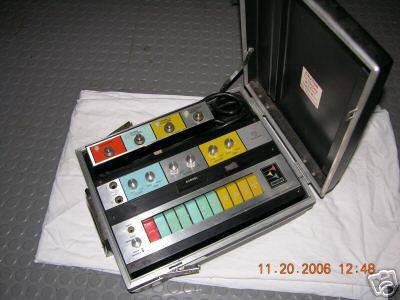 No title link, just a shot via this auction.
No title link, just a shot via this auction.Not much as far as details:
"I have a W-3 from Maestro, Never seen this before. It comes with its foot pedal and original case. It looks like a synths of sorts but I dont know that much about it. It looks like it was never used. I know the W-2 has sold for $455 + here on ebay, But cant find any reffrence to the W-3 but that Steely Dan used one. I really dont know how to play this thing, so sold as is. Its looks like it all working but dont know for sure. I will have more pics at http://synthsfl.tripod.com."
I couldn't find the pics. If did, feel free to comment.
Update via BirdFLU in the comments:
"Saxophonist Eddie Harris is probably the most famous user of the Maestro. Lookie here. Listen here"
Roland System 700
 Title link takes you to shots from this post for sale. That kid is going to make a mint. ; )
Title link takes you to shots from this post for sale. That kid is going to make a mint. ; )via Ben.
Vermona Performer
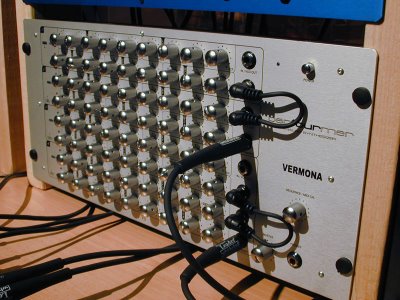 Title link takes you to shots pulled via this auction.
Title link takes you to shots pulled via this auction.Details:
-Not just 4 monosynths! You can chain them together as shown in the pics and get two dual-OSC, dual-ENV synths (mod VCA and VCF)
-Each synth 'channel' can be assigned to the same, or separate midi channels (so you could have suboscs, or detunes for fat hoover sounds, etc)
-Duo mode, in which incoming notes alternate between synth pairs 1&2 and 3&4
-Poly mode, in which incoming notes alternate between individual synth channels 1-> 2-> 3-> 4-> 1-> ...
-Awesome for live tweaking and immediacy in the studio
-Can be used as a filterbank to make your other gear sound better ;)
-An excellent 'seed' for a modular system - it would serve as four OSC modules or six -LP Filter modules
sample via the auction, also mirrored here.
Elektron Monomachine
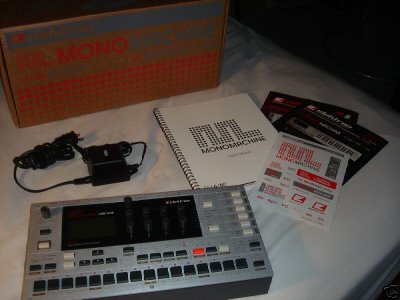 More boxy goodness. Double entendre intended. Title link takes you to more shots pulled via this auction.
More boxy goodness. Double entendre intended. Title link takes you to more shots pulled via this auction.
Waldorf MicroWave and Waveslave
 Title link takes you to shots pulled via this auction.
Title link takes you to shots pulled via this auction.Details via the auction:
"Original one owner Waldorf microWAVE & rare WAVEslave 8 voice expander. With these two units properly connected, you will have a 16 voice system. Both are in excellent condition cosmetically and functionally and come with all the original manuals and guides. Both the MW & WS have analog filters. The WS is a MW without memory or front panel controls. I have been told It is possible to operate the WS independent of the MW by using an editor such as sound diver or Galaxy. This MW has a very rich sound and is capable of producing a wide range of analog & digital sounds. This is the MW that everyone wants and this is your chance to own a rare 16 voice system."
Update via moogulator in the comments:
"the Waveslave does NOT allow V2.0 of the MW Software, so he may only sell V1.0 MWs andWaveesalve (which is not able to run with V2) .. those times you could send it in and get a replacement full MW1.. now the waveslave isn't the best idea, better go for 2 MW1 with V2.. "
There was another note that came in via the Waldorf forum as well. You can control the Waveslave via an MW1 V2 however if you play a patch with settings not supported in the Waveslave V1 software, the Waveslave will simply not play.
Anonymous Comments
So, I've noticed the majority of Anonymous Comments have turned into garbage since this post. Hmm.... I wonder why. I've noticed a few people complaining about them. So, I ask you the readers what do you think? Here are the options:
1. Disable Anonymous Comments altogether.
2. Allow Anonymous Comments but delete all negative Anonymous Comments.
3. Leave things as is
Let me know in the comments.
1. Disable Anonymous Comments altogether.
2. Allow Anonymous Comments but delete all negative Anonymous Comments.
3. Leave things as is
Let me know in the comments.
Monday, November 20, 2006
Jordon Rudess Demos the Roland VP-550
 Title link takes you to a few videos of Jordon Rudess demoing the Roland VP-550.
Title link takes you to a few videos of Jordon Rudess demoing the Roland VP-550.via synthesizer-magazin.
huppo studio
 Title link takes you to more shots.
Title link takes you to more shots.via huppo
Note: if you've been following this blog for some time you will realize cats seem to outnumber most other animals when it comes to the pets of synth owners and their synth shots. Not at huppo studio. I see a Beagle. : )
SynthMantra 1
 Title link takes you to a post on SoNiCbRat featuring an improv of the Zebra VCF, MOOG MF105, Casio SA5, Roland RS09, SH101 and Sherman Filterbank II.
Title link takes you to a post on SoNiCbRat featuring an improv of the Zebra VCF, MOOG MF105, Casio SA5, Roland RS09, SH101 and Sherman Filterbank II. That's the Zebranalogic VCF (from Peru) to the left of the Moogerfooger.
Update: Seems the URL for the mp3 isn't working. Sonicbrat sent over this link for now.
Rhodes Chroma Knob Box
 Remember the Rhodes Chroma knob box mentioned in this post? Title link takes you to a first look of the layout in PDF format.
Remember the Rhodes Chroma knob box mentioned in this post? Title link takes you to a first look of the layout in PDF format.Update: Waveshape knob added to the pdf.
PAiA Modular

Another one is up for sale. You can see the previous one here. This one is two cases. Click here for shots via this auction
The First Digital Synthesizers

A friend of mine asked me what the first digital synth was. To my surprise I wasn't sure. We all know it was the Yamaha DX7 (1983) that changed the landscape from analog to digital, but it clearly wasn't the first. The NED Synclavier (1975) and the Crumar/DKI GDS (197x?) and Synergy (1982) predate it. If anyone out there knows for sure, feel free to comment. Image of the Crumar/DKI GDS via synthony.
Snip on the GDS via Synthmuseum.com:
"'The GDS came out of some early research at Bell Laboratories in the early '70s,' explains Mercer 'Stoney' Stockell, who himself shared in developing the GDS and Synergy. 'Hal Alles, a researcher there, designed the high-speed additive engine that was put into the GDS and later systems. He was a very bright man. The work originally came out of some stuff he was supposed to be doing for echo-cancellation on telephone lines.'"
BTW, regarding the DX7, be sure to check out this post on the Yamaha FX1.
Update via adam s in the comments:
"The Dartmouth Digital Synthesizer is the Synclavier's ancestor. This is recognized as the first digital synthesizer existing as a self-contained instrument, closed system or whathaveyou. Of course, the first digital synthesizer (that is, first digital device to synthesize sound for the sake of music), is the IBM 704 Mainframe computer, on which Max Matthews created Music I in 1957. It's amazing how far computer synthesis predates 'digital synthesizers'. I'm sure that in that almost 20 year span, plently of people had developed (successfully or not) digital synthesizers, especially during the early 70's microprocessor boom."
LABELS/MORE:
Analogue Systems,
Crumar,
Dartmouth Digital Synthesizer,
GDS,
NED,
Synclavier,
Synergy,
Yamaha
Sunday, November 19, 2006
Circuit Bent Analog Synth Drum Machine
 Title link takes you to shots pulled via this auction.
Title link takes you to shots pulled via this auction.Details:
"Here is a totally unique old school circuit bent noise generator/synth. I picked up this mystery box recently and do not know any details as to its origin. My guess is it is early 70's home/custom built. The circuit board is hand wired bread board and it was done by someone who knew what they were doing. The sound is somewhere between a sound Aphex Twin might use or The 60's group Silver Apples. The tone can range from a drum machine like hi hat sound to bleeps with noise added in varying degrees. The tone frequency can vary the pitch and sounds like a pretty cool resonate filter. The emphasis puts the tone on a continous 4/4 to 4/2 4/3 4/1. Pretty simple overall but absolutely loads of fun to tweek in real time. The design is interesting in that it was built into a japanese wood box and works like a traditional music box, ie when you open the lid the unit is turned on. This is a self contained unit with a built in speaker. There are currently no provision for an output jack but that would be easy to do wired off the 2 leads from the speaker. I could not see what chips were used in the design as they are not visible without taking the unit apart. The unit runs on a hard wired 9v wall adapter. Maybe someone out there knows the origin of this vintage piece? Perhaps it was built for a specific music experimentor back in the day or just as a hobby project I do not know. At any rate this a cool conversation piece and a complete one off synth. Way kooler than a speak and spell! The unit measures 8.5 x 5 x 3.5 inches."
via Brian Comnes.
energyXT2
 energyXT2 is set to be released dec 1, 2006. Title link takes you to the energy-XT2 website which is pretty sparse, however, you can read more about it on Linux Rock Star. It will support Linux and Windows.
energyXT2 is set to be released dec 1, 2006. Title link takes you to the energy-XT2 website which is pretty sparse, however, you can read more about it on Linux Rock Star. It will support Linux and Windows.via Linux Rock Star:
"energyXT is an advanced music composer and plugin chainer. It can be run as a standalone application or as a plugin in another DAW to overcome it's limitations. energyXT2 is designed to be very easy to use with drag and drop, streamlined mixer and a very user friendly piano-roll. And when the final version of energyXT2 is out, it will have a built in synth/sampler and multi-effect processor so that you can create music “out of the box”."
This one via Inverseroom.
Analogue Haven Forum
Inverseroom wrote in to let me know Analogue Haven now has a forum, including a modular synth board. Title link takes you there.
Saturday, November 18, 2006
Replicant Samples
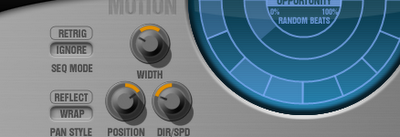 Remember Replicant? Well, it's not out just yet, however, Analog Industries has a few samples up. Title link takes you there.
Remember Replicant? Well, it's not out just yet, however, Analog Industries has a few samples up. Title link takes you there.
Fairlight CMI Keyboard
 Title link takes you to shots pulled via this auction.
Title link takes you to shots pulled via this auction.I saw this one on Failed Muso.
The auction also featured the videos below.
Peter Gabriel and Fairlight CMI
YouTube via Artmuzz. Previously posted here.
Al Di Meola Sequencer 1982
YouTube via dorataro
Kate Bush - Experiment IV (Wogan)
YouTube via gaffahead
Fairlight IIL Demonstration at Syco Systems
YouTube via Synthasy2000. BTW you can get DVDs with this particular video and more here. Look for DVD on the left when you get there.
Synton Syrinx

via this auction. Note all the other synths on the list as well.
Note it's a black Syrinx with a blue lower case.
PREVIOUS PAGE
NEXT PAGE
HOME













© Matrixsynth - All posts are presented here for informative, historical and educative purposes as applicable within fair use.
MATRIXSYNTH is supported by affiliate links that use cookies to track clickthroughs and sales. See the privacy policy for details.
MATRIXSYNTH - EVERYTHING SYNTH













© Matrixsynth - All posts are presented here for informative, historical and educative purposes as applicable within fair use.
MATRIXSYNTH is supported by affiliate links that use cookies to track clickthroughs and sales. See the privacy policy for details.
MATRIXSYNTH - EVERYTHING SYNTH
